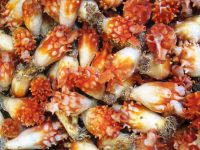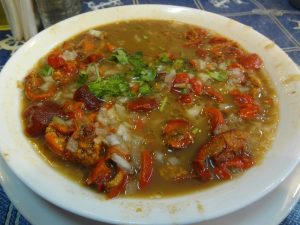Memo #283
By Hyung-Gu Lynn – hlynn [at] mail.ubc.ca
 Ten years ago today, April 1, 2004, the Chile-South Korea free trade agreement (FTA) came into effect. This landmark agreement marked Chile’s first FTA with an Asian country, and South Korea’s first FTA altogether. But what do sea squirts (Korean meonggye/Spanish piure) have to tell us about FTAs?
Ten years ago today, April 1, 2004, the Chile-South Korea free trade agreement (FTA) came into effect. This landmark agreement marked Chile’s first FTA with an Asian country, and South Korea’s first FTA altogether. But what do sea squirts (Korean meonggye/Spanish piure) have to tell us about FTAs?
Within the past ten years, there has been roughly a 4.5-fold increase in the trade volume between Chile and South Korea. Today, Chilean wines, grapes, and salmon can be readily found in Seoul supermarkets, while Korean automobiles are a common sight on the streets of Santiago. Korea and Chile are two of the main consumers of sea squirts in the world, and tariffs on this product were eliminated under the FTA, yet the sea squirt has not joined the increasingly voluminous trade stream between the two countries. Rather, Chileans and South Koreans have largely remained consumers of their own variety of this sea delicacy.
Consumers tend to focus on increases in the variety and decreases in the prices of products. But product accessibility is only one element in the complex calculus of assessing FTA impact. While government officials often focus in their public statements on export volume and job growth, customs officials worry about potential reductions in tariff revenue stemming from FTAs. If economists often emphasize the overall balance of macro-level welfare and efficiency gains, businesses generally concentrate on sector specific impacts. The media always report on both support for and concerns about the potential effects of FTAs. But deadlines can limit coverage of more complex analyses that are conducted of projected (ex ante) and actual (ex post) impacts involving margin effects (preferential margin), RoO effects (rules of origin restrictions), and scale effects (average export volumes).
Admittedly, the shape, colour, and taste of these sea squirts do differ – the Chilean piure is shaped like a rock and its flesh is generally bright red when fresh, while the Korean meonggye is shaped like a pear and its flesh is orange. But the sea squirt reminds us that FTAs are complex mechanisms that always generate mixed results. Tariff rates, specific terms of agreement, and even personal tastes are important, but these do not determine product availability. Individual effort and entrepreneurship or agency can still shape outcomes at the product specific level.
About the Author:
Hyung-Gu Lynn is the AECL/KEPCO Chair in Korean Research at the Institute of Asian Research, University of British Columbia, where he also serves as Editor of the journal Pacific Affairs as well as the Asia Pacific Memo.
Links:
- Sung-Hoon Park and Min Gyo Koo, “Forming a Cross-regional Partnership: The South Korea-Chile FTA and Its Implications,” Pacific Affairs, 80, no. 2 (2007): 259–278.
- Scientific American Blog Running Ponies, “Pyura chilensis: the closest thing to getting blood from a stone,” June 2012
- Kim Huicheol, “A Study on Changes in the Competitiveness of Korean Exports: Focusing on Pre and Post Korea-Chile FTA,” Gieop gyeongyeong yeon’gu, 51 (2013): 265-280 (In Korean)
- Anuarios Estadísticos de Servicio Nacional de Pesca y Acuicultura (Chilean Statistical Yearbook of National Fisheries and Aquaculture) (In Spanish)

Live sea squirts (meonggye) of the South Korean variety (Credit: ProjectManhattan).
Related Memos:
See our other memos on South Korea.

Comments are closed, but trackbacks and pingbacks are open.